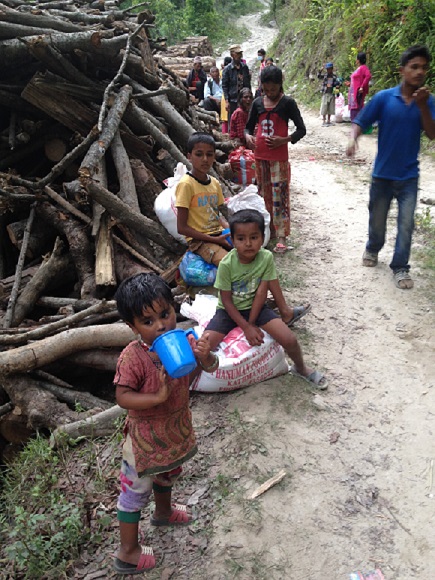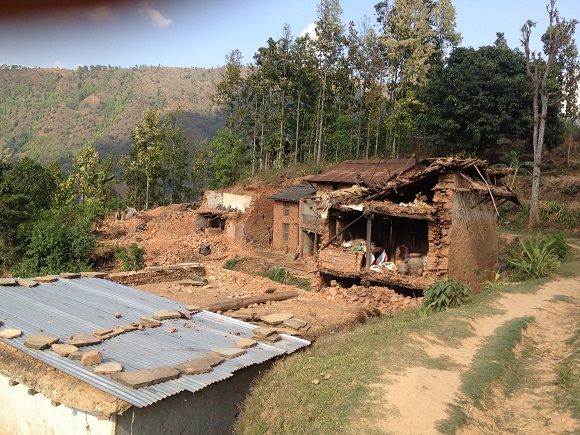 Despite high levels of desperation and vulnerability, the villagers formed an orderly queue to receive relief packages. Image credit: Subindra Bogati
Despite high levels of desperation and vulnerability, the villagers formed an orderly queue to receive relief packages. Image credit: Subindra BogatiRebuilding villages from the ground up
In the wake of Nepal's mega-quake, we have been visiting affected areas. Under the instruction of our colleagues on the ground, we first headed for the isolated village of Mahadevisthan, 35 kilometres from Kathmandu. From the road, the vastness of the destruction was evident; roadside villages were overwhelmed by rubble and devastation. Dandagaun of Mahadevisthan has no main connecting road, making it highly inaccessible. The acute isolation of this village has hindered the delivery of bare essentials, aggravating the humanitarian crisis at hand.
The lack of sanitation and communal living is yet to cause significant health problems in the village, but with the monsoon season just around the corner the situation is likely to worsen. Cholera will almost certainly arise in some devastated rural parts of Nepal, where medical facilities are limited and communal water systems are easily contaminated. The hot and wet conditions expected in the months to come provide the perfect conditions for waterborne diseases to thrive.
 The earthquake has destroyed properties and livelihoods, and rebuilding infrastructure will take time. Image credit: Subindra Bogati
The earthquake has destroyed properties and livelihoods, and rebuilding infrastructure will take time. Image credit: Subindra BogatiThe necessity of relief: rebuilding broken communities
Our next port of call was the district of Rasuwa, where we visited the villages of Laharepauwa and Dhaibung. We were greeted on arrival with silk scarves, a kind gesture of gratitude from the villagers. Houses in these villages are scattered around the hills, thus making them difficult to reach. The villages are mostly inhabited by Tamangs, a marginalised group. Rather than distributing the supplies ourselves, the size of this village rendered it more effective to leave supplies in the communal hall, allowing the villagers to distribute the supplies amongst themselves. We were pleased to see that both villages still had access to running water, despite the damage. As in Dandagaun, our aid was warmly received, and was the first of its kind since the devastating earthquake 11 days before. This time we also brought 22 tents, as the village was lacking in sufficient temporary shelter for all its members. We left the village in the knowledge that our work there was vital, but that there was far more to be done long-term to help rebuild this broken community.
Rebuilding infrastructure will take time; the worst hit villages tend to be scattered, poorly connected and lie within mountainous terrain, making them highly inaccessible. Furthermore, many of the roads to these areas were completely destroyed by the quake. The monsoon is likely to see a worsening of this situation if roads are not repaired in time, as heavy rains frequently induce landslides in the area. The rural villages that we visited do not produce sufficient food to sustain the whole village, and therefore are partially dependent on supplies being transported from elsewhere. Road blockages inhibit the flow of goods into villages, heightening the fragility of the situation in rural parts.
Next steps: what action is needed?
- Monsoon season is just a couple of months away. It is estimated that 200,000 people are currently living under the open sky. It is important that these people are supplied with tents or some other form of makeshift home. There is need for toilets, if we are to keep the threatening sanitation crisis at bay.
- Roads in many districts have been severely damaged by the earthquake. It is important that these roads are repaired before the arrival of the monsoon, to prevent further suffering of isolated communities.
- The food supply managed by national and international organisations will soon dwindle. Either the government increases its presence and effectiveness, or communities will be forced to find their own way to survive.
- The monsoon season will help both small and large farmers to harvest sufficient foods for their families that should last months. It is important that the government or other stakeholders provide seeds for agriculture; rice, corn and millet are the crops typically grown. In many cases we have witnessed, the seeds needed for harvest have been buried in rubble.
- Despite the destruction, some families are able to rebuild their homes without external manual assistance. The government needs to provide interest-free loans to the quake victims to enable them to purchase necessary material and equipment, gradually repaying the government over subsequent years.
- The formidable task of rebuilding infrastructure should be fulfilled by local people; some form of ‘cash for work’ policy would see a double benefit of a stimulated local economy and the re-emergence of basic infrastructure.
- Nearly five thousands schools have been destroyed by the quake. It is important that we re-build these schools as soon as possible so that children can return to school.
Our visits to the districts have helped us to identify children as the most vulnerable group in these already marginalised communities. For a sense of normality to return, it is important that funding is available for school books, uniforms, and other basic but essential items such as pens and paper, which were lost in the destruction. The provision of these items will facilitate the return to normality that is so essential for children in the wake of a crisis. Schooling can provide stability for children, and it is essential that children are able to continue their studies, despite the adverse circumstances witnessed in rural villages.
Nepal Peacebuilding Initiative has been providing emergency supplies to the victims of earthquake in Nepal. It plans to help children of marginalised and dalits to go back to the schools. Please support if you can at the following link: https://www.gofundme.com/tufrew.







